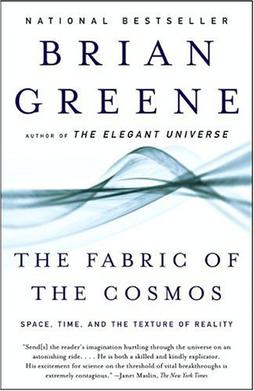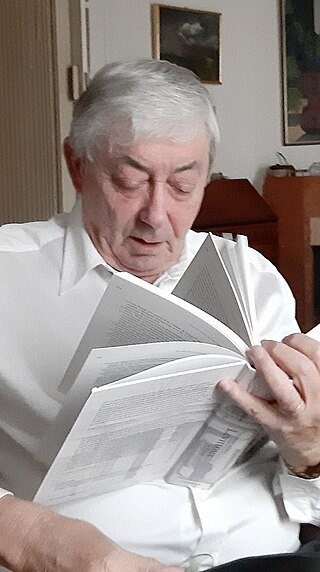M-theory is a theory in physics that unifies all consistent versions of superstring theory. Edward Witten first conjectured the existence of such a theory at a string theory conference at the University of Southern California in 1995. Witten's announcement initiated a flurry of research activity known as the second superstring revolution. Prior to Witten's announcement, string theorists had identified five versions of superstring theory. Although these theories initially appeared to be very different, work by many physicists showed that the theories were related in intricate and nontrivial ways. Physicists found that apparently distinct theories could be unified by mathematical transformations called S-duality and T-duality. Witten's conjecture was based in part on the existence of these dualities and in part on the relationship of the string theories to a field theory called eleven-dimensional supergravity.
In physics, string theory is a theoretical framework in which the point-like particles of particle physics are replaced by one-dimensional objects called strings. String theory describes how these strings propagate through space and interact with each other. On distance scales larger than the string scale, a string looks just like an ordinary particle, with its mass, charge, and other properties determined by the vibrational state of the string. In string theory, one of the many vibrational states of the string corresponds to the graviton, a quantum mechanical particle that carries the gravitational force. Thus, string theory is a theory of quantum gravity.

A theory of everything (TOE), final theory, ultimate theory, unified field theory or master theory is a hypothetical, singular, all-encompassing, coherent theoretical framework of physics that fully explains and links together all aspects of the universe. Finding a theory of everything is one of the major unsolved problems in physics.
In physics and astronomy, a frame of reference is an abstract coordinate system whose origin, orientation, and scale are specified by a set of reference points―geometric points whose position is identified both mathematically and physically.
In philosophy, the philosophy of physics deals with conceptual and interpretational issues in physics, many of which overlap with research done by certain kinds of theoretical physicists. Historically, philosophers of physics have engaged with questions such as the nature of space, time, matter and the laws that govern their interactions, as well as the epistemological and ontological basis of the theories used by practicing physicists. The discipline draws upon insights from various areas of philosophy, including metaphysics, epistemology, and philosophy of science, while also engaging with the latest developments in theoretical and experimental physics.

Mathematical physics refers to the development of mathematical methods for application to problems in physics. The Journal of Mathematical Physics defines the field as "the application of mathematics to problems in physics and the development of mathematical methods suitable for such applications and for the formulation of physical theories". An alternative definition would also include those mathematics that are inspired by physics, known as physical mathematics.
Theodor Franz Eduard Kaluza was a German mathematician and physicist known for the Kaluza–Klein theory, involving field equations in five-dimensional space-time. His idea that fundamental forces can be unified by introducing additional dimensions were reused much later for string theory.
Laurent Freidel is a French theoretical physicist and mathematical physicist known mainly for his contributions to quantum gravity, including loop quantum gravity, spin foam models, doubly special relativity, group field theory, relative locality and most recently metastring theory. He is currently a faculty member at Perimeter Institute for Theoretical Physics in Waterloo, Ontario, Canada.

Erik Peter Verlinde is a Dutch theoretical physicist and string theorist. He is the identical twin brother of physicist Herman Verlinde. The Verlinde formula, which is important in conformal field theory and topological field theory, is named after him. His research deals with string theory, gravity, black holes and cosmology. Currently, he works at the Institute for Theoretical Physics at the University of Amsterdam.
Since the 19th century, some physicists, notably Albert Einstein, have attempted to develop a single theoretical framework that can account for all the fundamental forces of nature – a unified field theory. Classical unified field theories are attempts to create a unified field theory based on classical physics. In particular, unification of gravitation and electromagnetism was actively pursued by several physicists and mathematicians in the years between the two World Wars. This work spurred the purely mathematical development of differential geometry.

The Fabric of the Cosmos: Space, Time, and the Texture of Reality (2004) is the second book on theoretical physics, cosmology, and string theory written by Brian Greene, professor and co-director of Columbia's Institute for Strings, Cosmology, and Astroparticle Physics (ISCAP).

A five-dimensional space is a space with five dimensions. In mathematics, a sequence of N numbers can represent a location in an N-dimensional space. If interpreted physically, that is one more than the usual three spatial dimensions and the fourth dimension of time used in relativistic physics.
Daniel Harry Friedan is an American theoretical physicist and one of three children of the feminist author and activist Betty Friedan. He is a professor at Rutgers University.
Itzhak Bars is a theoretical physicist at the University of Southern California in Los Angeles.
In non-technical terms, M-theory presents an idea about the basic substance of the universe. Although a complete mathematical formulation of M-theory is not known, the general approach is the leading contender for a universal "Theory of Everything" that unifies gravity with other forces such as electromagnetism. M-theory aims to unify quantum mechanics with general relativity's gravitational force in a mathematically consistent way. In comparison, other theories such as loop quantum gravity are considered by physicists and researchers to be less elegant, because they posit gravity to be completely different from forces such as the electromagnetic force.
Superstring theory is an attempt to explain all of the particles and fundamental forces of nature in one theory by modeling them as vibrations of tiny supersymmetric strings.
Jerzy Juliusz Kijowski – Polish physicist, Professor of Physical Sciences who specializes in physics, mathematics, classical and quantum field theory, and theory of gravity.
In physics, a non-relativistic spacetime is any mathematical model that fuses n–dimensional space and m–dimensional time into a single continuum other than the (3+1) model used in relativity theory.

Richard Kerner is a French theoretical physicist andProfessor Emeritus of Pierre and Marie Curie University whose research extends into gravitation, cosmology, field theory, solid-state physics, noncommutative geometry, quantum mechanics and mathematical and theoretical biology.
Hermann Nicolai is a German theoretical physicist and director emeritus at the Max Planck Institute for Gravitational Physics in Potsdam-Golm.






